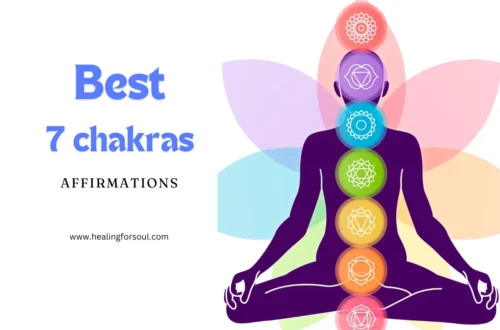What Are Mantras?
Mantras are holy sounds or phrases that have a spiritual meaning across different religions and belief systems. They are usually taken from Sanskrit, the language of Hinduism, and can contain just syllables, words, or short phrases. They are repeated silently during meditation, prayer, or ritual ceremonies. The connotation that is conveyed by a mantra can be simple, conveying a message, or symbolic, as it suggests a deeper spiritual meaning. Regardless of the form, mantras are believed to help focus the mind, cultivate positive emotions, and elevate consciousness.
Unraveling Ancient Insights
Embark on a captivating journey into the realm of mantras – those mystical utterances whispered during moments of meditation and spiritual communion. Originating in the ancient Indus Valley and the venerable Vedic epoch of India, the saga of mantras traverses epochs and continents, leaving an indelible mark on the tapestry of spiritual wisdom. Delve into the annals of history to uncover the genesis of mantras within the Vedas, the timeless scriptures of Hinduism. Penned between 1700 -1100 BCE, these sacred texts extol the potency of sound, deifying speech as Vac, the goddess. Within Vedic rituals, the meticulous chanting of hymns was revered as the conduit to divine communion.
Mantras: Incantations of the Mind
Etymologically rooted in Sanskrit, the term “mantra” epitomizes an instrument of cognition, with “man” signifying thought and “tra” denoting instrumentality. Thus, mantras emerge as cognitive catalysts, fostering concentration, clarity, and spiritual elevation. Across the Vedas, diverse mantras, including the revered Rc verses and Sama chants, are enshrined.
Mantras: Gateways to Transcendence
In the Vedic ethos, the Vedas are revered as “Sruti” – the primordial sounds resonating through the ages. Passed down orally, mantras embody the essence of this divine revelation, illuminating pathways to spiritual ascension. Explored within Upanishads, these sacred syllables, epitomized by the venerable Aum (Om), unravel profound truths.
Mantras: Bridges Across Spiritual Traditions
Beyond the confines of Hinduism, mantras permeate the tapestry of Dharmic religions – Buddhism, Jainism, and Sikhism. In Buddhism, mantras serve as conduits to meditative absorption, nurturing virtues of compassion and insight. Jainism harnesses mantras for spiritual purification and emancipation, underscoring their universality.
The Eternal Reverberations of Mantras
Today, amidst the tranquil serenity of Buddhist monasteries and the rhythmic cadence of yogic reverie, mantras endure as perennial beacons of spiritual illumination. Their reverberating resonance, resonating across time and space, continues to guide seekers on the path to inner tranquility and spiritual enlightenment.
Understanding Mantra Meanings
Mantras, those sacred vibrations resonating deep within our beings, possess a profound potency far beyond mere verbal recitation. While the audible resonance holds transformative power, delving into the meanings behind these sacred sounds unveils layers of connection and intention within your spiritual journey.
Literal vs. Subtle Significance:
Originating from Sanskrit, a language revered for its precision and profundity, mantras reveal dual facets of meaning:
Literal Meaning: This surface level offers a direct interpretation of the mantra’s words. For instance, “Om Shanti Shanti Shanti” translates to “Om peace, peace, peace.”
Subtle Significance: Beneath the surface lies a hidden realm of symbolism and spiritual depth. In the same example, “Om” symbolizes the universe, while “Shanti” embodies peace. Together, they invoke a sense of universal harmony and interconnectedness.
Consult Reliable Sources: Seek guidance from esteemed mentors, authoritative texts on mantra traditions, or reputable online resources endorsed by established spiritual institutions.
Consider Context: Each mantra carries unique nuances influenced by its originating tradition, associated deity, or intended purpose within specific spiritual practices. Understanding these contextual elements illuminates deeper layers of significance.
Explore Symbolism: Many mantras are woven with rich symbolic threads. Delving into these symbolic layers unveils profound insights and deeper understandings.
Beyond Verbalization: The Power of Experience
While intellectual comprehension lays a foundation, the true essence of a mantra manifests through experiential engagement:
Meditation: Integrate the mantra into your meditation regimen, allowing its resonance to penetrate your consciousness. As you immerse yourself in the sound and vibration, intuitive insights and revelations may arise spontaneously.
Devotion: Cultivate reverence towards the deity associated with the mantra, fostering a deeper connection to its essence and significance.
Benefits of Mantra Meditation
Mantra meditation, a profound practice harnessing repetitive chants or phrases to anchor the mind, unveils a plethora of benefits spanning mental and physical realms. Here’s a detailed exploration of its profound advantages:
Reduced Stress and Anxiety:
The rhythmic cadence of mantra repetition serves as a sanctuary, allowing the mind to disengage from the tumult of worries and anxieties.
Scientific studies affirm that mantra meditation elicits a relaxation response, thereby mitigating blood pressure and heart rate, and fostering a serene equilibrium.
Enhanced Focus and Concentration:
Channeling attention towards the mantra quells the ceaseless chatter of the mind, augmenting concentration and sustaining focus over extended durations. This sharpened focus amplifies performance across diverse domains, from professional endeavors to scholastic pursuits.
Increased Self-Awareness:
Mantra meditation fosters a state of serene introspection, enabling impartial observation of one’s thoughts and emotions.
Through nonjudgmental introspection, individuals attain profound insights into their inner dynamics and subconscious patterns.
Improved Emotional Regulation:
Regular engagement in mantra meditation equips practitioners with adept strategies to navigate tumultuous emotions with composure.
By tranquilizing the mind and nurturing inner harmony, individuals cultivate resilience against emotional triggers.
Boosted Positivity:
Many mantras encapsulate affirmative sentiments such as peace, love, and compassion, infusing practitioners with a buoyant emotional disposition.
Regular recitation of these mantras engenders a pervasive aura of optimism and upliftment.
Physical Health Benefits:
The relaxation response instigated by mantra meditation exerts salubrious effects on physical well-being, ameliorating blood pressure and bolstering cardiovascular health.
Emerging research indicates potential fortification of the immune system through sustained practice.
Spiritual Growth:
Across myriad traditions, mantras are revered as conduits to spiritual realms, facilitating communion with transcendental realms or nurturing specific spiritual virtues.
Chanting mantras serves as a sacred invocation, fostering spiritual elevation and inner sanctity.
Accessibility and Simplicity:
Mantra meditation offers a facile entry point into contemplative practice, requiring minimal resources and accommodating diverse lifestyles.
Its versatility renders it adaptable to varied environments, rendering it accessible to a broad spectrum of individuals.
Incorporating Mantras into Daily Life
Mantras, those potent affirmations echoing with resonance, serve as indispensable allies in infusing mindfulness and intention into the hustle and bustle of daily existence. Here’s a compendium of pragmatic strategies to seamlessly weave mantras into your everyday tapestry:
Finding Your Mantra Match:
Explore Different Traditions: Venture beyond familiar territories, delving into diverse spiritual paths to unearth a mantra resonating with your soul. Seek guidance from online repositories or esteemed mentors for inspiration.
Consider Your Needs:
Tailor your choice of mantra to align with your prevailing aspirations. Whether craving serenity, concentration, or motivation, select a mantra that mirrors your current intention.
Keep it Meaningful:
While the sonic resonance holds potency, delving into the profound significance of your chosen mantra deepens your affinity and connection with its transformative power.
Waking Up to Mantras:
Morning Mantra Ritual: Commence your day with a sanctified pause, dedicating a few moments to silent meditation punctuated by the rhythmic chanting of your chosen mantra. Set a positive trajectory for the day ahead through this sacred invocation.
Shower Affirmations:
Infuse your morning ablutions with sacred intent by silently intoning your mantra amidst the cascading water, symbolizing a purifying cleanse of negative energies.
Mantra Magic Throughout the Day:
Traffic Transformation: Harness the transit hours for introspective communion. Engage in mantra meditation during your commute, utilizing the rhythmic cadence to navigate the vehicular chaos with equanimity.
Mindful Moments:
Infuse mundane chores with mindful presence by intertwining mantras into your daily tasks. Embrace patience during laundry folding with a mantra of tranquility, or express gratitude through culinary creations with a chanting melody.
Mini-Meditations:
Take short breaks throughout the day. Close your eyes for a minute, silently intoning your mantra to anchor yourself in the present moment amidst the whirlwind of activity.
Bedtime Bliss:
Conclude your day with a serene symphony, indulging in a bedtime ritual of mantra recitation to lull the mind into tranquil repose.
Journaling with Mantras:
Engage in reflective introspection through evening journaling, encapsulating the day’s experiences and aspirations. Seal the contemplative session by inscribing your chosen mantra as a beacon of guidance for the morrow.
Mantras for Stress Relief
In the whirlwind of daily life, stress can easily take hold. Luckily, mantras can be powerful tools to combat stress and find inner peace. Here are some specific mantras traditionally used for stress relief:
Universal Mantras:
Om: This single-syllable mantra is considered the primal sound of the universe. Chanting “Om” with focus can be deeply calming and centering.
So Hum: Translating to “I am That,” this mantra reminds you of your connection to the divine and the ever-present reality.
Mantras for Peace:
Om Shanti Shanti Shanti: Meaning “Om peace, peace, peace,” this mantra invokes a sense of universal peace and tranquility.
Shanti Patha: This longer Sanskrit chant specifically translates to “recitation of peace.” It’s a beautiful and powerful invocation of peace for oneself and the world. Mantras for Strength and Resilience:
Lokah Samasta Sukhino Bhavantu: This Sanskrit mantra translates to “May all beings be happy and free.” Cultivating compassion for others can indirectly reduce your stress. I am strong. I am capable. I am calm. This simple mantra is a powerful affirmation of your inner strength and ability to handle challenges.
Choosing Your Mantra:
The most effective mantra for stress relief is the one that resonates most deeply with you. Choose a mantra with a meaning that brings you comfort and a sense of peace. Sound Listen to the sound of the mantra. Does it evoke feelings of calmness and relaxation? Personal Connection Pick a mantra that feels right for you at this moment. There’s no right or wrong choice.
Using Your Mantra:
Mindful Repetition Silently repeat your chosen mantra throughout the day, especially during stressful situations. Incorporate your mantra into your meditation practice. Focus on the sound and vibration of the mantra as you chant. Write down your mantra and reflect on its meaning. This can deepen your connection to it.







